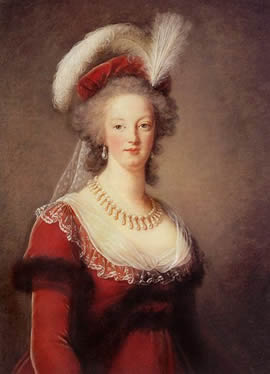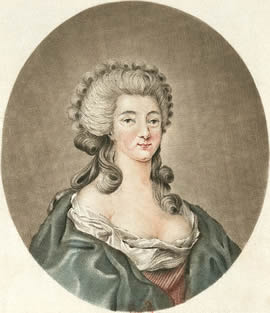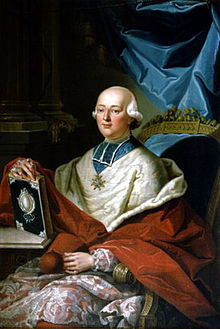Three Women behind the Diamond Necklace Affair
 The Diamond Necklace reconstruction
The Diamond Necklace reconstruction
The Affair of the Diamond Necklace was an incident in the 1780s at the court of Louis XVI of France involving his wife, Queen Marie Antoinette. The reputation of the Queen, which was already tarnished by gossip, was ruined by the implication that she had participated in a crime to defraud the crown jewellers of the cost of a very expensive diamond necklace. The Affair was historically significant as one of the events that led to the French populace's disillusionment with the monarchy, which, among other causes, eventually culminated in the French Revolution.
Background of Diamond Necklace
In 1772, Louis XV ( King of France from 1-9-1715 until his death) decided to make Madame du Barry (the chief mistress of the king of France), with whom he was infatuated, a special gift at a very huge cost of 2,000,000livres. He requested that Parisian jewelers Boehmer and Bassenge create a diamond necklace which would surpass all others in magnificence and majesty. It would take the jewelers several years and a great deal of money to amass an appropriate set of diamonds. In the meantime, Louis XV died of smallpox, and du Barry was banished from court by his successor.
 Marie Antoinette, the Queen of France
Marie Antoinette, the Queen of France
 Madame du Barry, the chief mistress of earlier King Louis XV
Madame du Barry, the chief mistress of earlier King Louis XV
The necklace consisted of many large diamonds arranged in an elaborate design of festoons, pendants andtassels. The jewelers hoped it could be a product that the new Queen of France, Marie Antoinette, could buy and indeed in 1778 the new king, Louis XVI, offered it to his wife as a present, but she refused. According to Madame Campan, the Queen refused it with the statement that the money would be better spent for war equipment. Some said that Marie Antoinette refused the necklace because she did not want to wear any jewel that had been designed for another woman, especially if that woman was a courtesan she disliked. After having vainly tried to place the necklace outside of France, the jewelers again attempted to sell it to Marie Antoinette in 1781. The Queen again refused.
The Affair
There was notorious lady named Jeanne de la Motte, who was a descendant of an illegitimate son of Henry II of France. Jeanne had married an army officer and was living on a small pension which the King had granted her.Jeanne was described as having been slender with small breasts; she had white skin, chestnut-brown hair, limpid blue eyes, and a "winning smile". Jeanne de la Motte conceived a plan to use the necklace to gain wealth and possibly power and royal patronage. In March 1785 Jeanne became the mistress of the Cardinal de Rohan, a former French ambassador to the court of Vienna. The Cardinal was regarded with displeasure by Queen Marie Antoinette (the Queen of France and the wife of King of France Louis XVI).
At this time, the Cardinal was attempting to regain the Queen's favour in order to become one of the King's ministers. Jeanne de la Motte, having entered court by means of her lover named Rétaux de Villette, persuaded Cardinal Rohan that she had been received by the Queen and enjoyed her favour. On hearing of this, Rohan resolved to use Jeanne to regain the Queen's goodwill. Jeanne assured the Cardinal that she was making efforts on his behalf.
This began an alleged correspondence between Rohan and the Queen, the returning replies to Rohan's notes, which she affirmed came from the Queen. The tone of the letters became very warm, and the Cardinal, convinced that Marie Antoinette was in love with him, became charmed of her. He begged Jeanne to arrange a secret night-time interview for him with the Queen, and the supposed meeting took place in August 1784. In the garden of the Palace of Versailles, the Cardinal met with a woman whom he believed to be the Queen. This woman was in fact a prostitute, Nicole d'Oliva, who had been hired by Jeanne because of her resemblance to the Queen. Rohan offered d'Oliva a rose, and, in her role as the Queen, she promised him that she would forget their past disagreements.
Jeanne de la Motte took advantage of the Cardinal's belief in her by borrowing large sums of money from him, telling him that they were for the Queen’s charity work. With this money, Jeanne was able to make her way into respectable society. Because she openly boasted about her relationship with the Queen, many assumed the relationship was genuine.
The jewellers Boehmer and Bassenge resolved to use her to sell their necklace. She at first refused a commission, but then changed her mind and accepted it.
 Jeanne de la Motte, notorious lady & master mind behind Diamond Necklace affair
Jeanne de la Motte, notorious lady & master mind behind Diamond Necklace affair
 The Cardinal de Rohan
The Cardinal de Rohan
The "Queen" sent several letters to the cardinal, including an order to buy the necklace; they were signed Marie Antoinette de France, but the Cardinal either didn't know or didn't remember that French queens signed with their given names only.
On 21 January 1785, Jeanne told the Cardinal that Marie Antoinette wanted to buy the necklace; but, not wishing to purchase such an expensive item publicly during a time of need, the Queen wanted the Cardinal to act as a secret intermediary. A little while later, Rohan negotiated the purchase of the necklace for 2,000,000livres, to be paid in installments. He claimed to have the Queen's authorization for the purchase, and showed the jewellers the conditions of the bargain in the Queen's handwriting. Rohan took the necklace to Jeanne's house, where a man, whom Rohan believed to be a valet of the Queen, came to fetch it. Jeanne de la Motte's husband secretly took the necklace to London, where it was broken up in order to sell the large individual diamonds separately.
When time came to pay the amount, Jeanne de la Motte presented the Cardinal's notes, but these were insufficient. Boehmer complained to the Queen, who told him that she had neither ordered nor received the necklace. She had the story of the negotiations repeated for her. On 15 August 1785, the Feast of the Assumption, while the court was awaiting the King and Queen to go to the chapel, the Cardinal de Rohan, who was to officiate, was taken before the King, the Queen, the Minister of the Court to explain himself. Rohan produced a letter signed "Marie Antoinette de France". On reading this, the King became furious that Rohan, could have let himself be fooled, since royalty do not use surnames. Rohan was arrested and taken to the Bastille; on the way he sent home a note ordering the destruction of his correspondence. Jeanne was not arrested until three days later, giving her a chance to destroy her papers.
The police arrested the prostitute Nicole d'Oliva and Rétaux de Villette, who confessed that he had written the letters given to Rohan in the queen's name, and had imitated her signature.
A sensational trial resulted in the acquittal of the Cardinal and the prostitute d'Oliva on 31 May 1786. Jeanne de la Motte was condemned to be whipped, branded with a V (for voleuse, "thief") on each shoulder, and sent to life imprisonment in the prostitutes' prison at the Salpêtrière. In June of the following year she escaped from prison disguised as a boy. Meanwhile, her husband was condemned to the galleys for life. The forger Villette was banished.
The Queen, a manipulative spendthrift?
Public opinion was much excited by this trial. Most historians come to the conclusion that Marie Antoinette was relatively blameless in the matter, that Rohan was an innocent dupe, and that the Jeanne La Mottes deceived both for their own ends. This was also broadly the finding of the Paris Parlement, although they did not comment on the actions of the Queen.
Despite the findings to the contrary, many people in France persisted in the belief that the Queen had used the Jeanne La Mottes as an instrument to satisfy her hatred of the Cardinal de Rohan. Various circumstances fortified this belief. There was the Queen's disappointment at Rohan's acquittal, and the fact that the Cardinal was afterwards deprived by the King of his charges and exiled to the monastery in south-central France. In addition, the people assumed that the Parlement de Paris's acquittal of Rohan implied that Marie Antoinette was somehow in the wrong. All of these factors led to a huge decline in the Queen's popularity and encouraged an image of her among the masses as a manipulative spendthrift, interested more in vanity than in the welfare of France and the French. Jeanne de la Motte took refuge in London and in 1789 she published her memories, in which she once again accused the Queen.
Significance
The affair of the diamond necklace was important in discrediting the Kingdom, Bourbon monarchy in the eyes of the French people, four years before the French Revolution. Marie Antoinette became even more unpopular, and malicious gossip about her made her even more of a liability to her husband. She was never able to shake off the idea in the public imagination that she had perpetrated an extravagant fraud for her own frivolous ends. Nonetheless, the affair prompted Louis XVI to become closer to his wife, and may have inclined him to be more defensive of and more responsive to her leading up to the revolution.